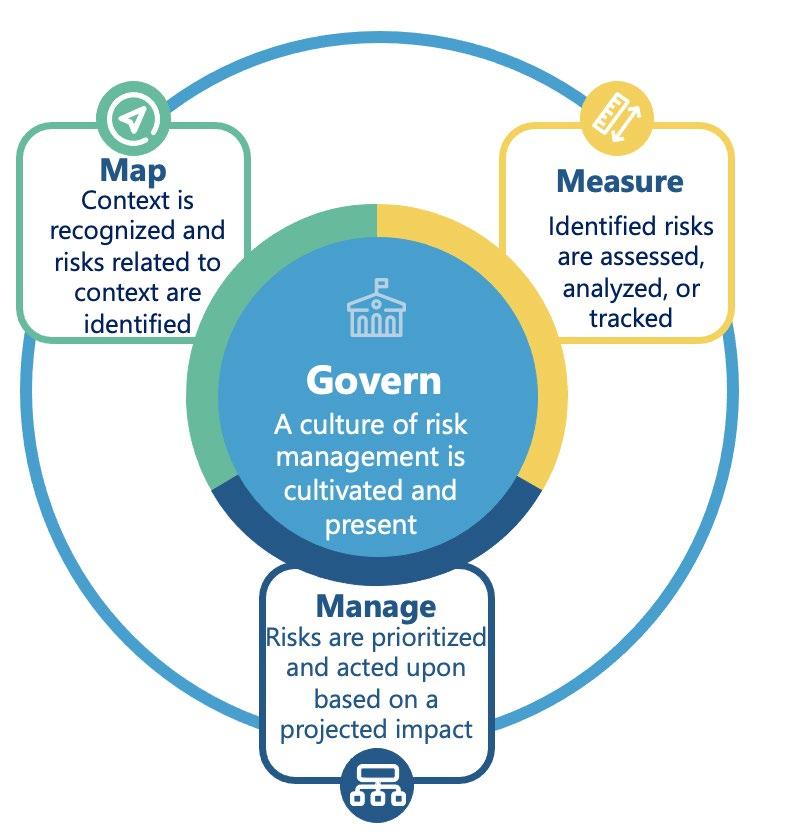
4 minute read
6.1. Govern
Framework users may apply these functions as best suits their needs for managing AI risks. Some organizations may choose to select from among the categories and subcategories; others will want and have the capacity to apply all categories and subcategories. Assuming a governance structure is in place, functions may be performed in any order across the AI lifecycle as deemed to add value by a user of the framework. After instituting the outcomes in Govern, most users of the AI RMF would start with the Map function and continue to Measure or Manage. However users integrate the functions, the process should be iterative, with crossreferencing between functions as necessary. Similarly, there are categories and subcategories with elements that apply to multiple functions, or that have to occur before certain subcategory decisions.
Risk management should be continuous, timely, and performed throughout the AI system lifecycle dimensions. AI RMF core functions should be carried out in a way that reflects diverse and multidisciplinary perspectives, potentially including the views of stakeholders from outside the organization. Having a diverse team contributes to more open sharing of ideas and assumptions about the purpose and function of the technology being designed and developed – which can create opportunities for surfacing problems and identifying existing and emergent risks.
Advertisement
An online companion resource to the AI RMF, referred to as the NIST AI RMF Playbook, is available to help organizations navigate the AI RMF and achieve the outcomes through suggested tactical actions they can apply within their own contexts. The Playbook is voluntary and organizations can utilize the suggestions according to their needs and interests. Playbook users can create tailored guidance from suggested material for their own use, and contribute their suggestions for inclusion to the broader Playbook community. Along with the AI RMF, the NIST Playbook will be part of the forthcoming Trustworthy and Responsible AI Resource Center.
The Govern function cultivates and implements a culture of risk management within organizations developing, deploying, or acquiring AI systems. Governance is designed to ensure risks and potential impacts are identified, measured, and managed effectively and consistently. Governance provides a structure through which AI risk management functions can align with organizational policies and strategic priorities whether or not they are related to AI systems. Governance focuses on technical aspects of AI system design and development as well as on organizational practices and competencies that directly affect the individuals involved in training, deploying, and monitoring of such systems. Governance should address supply chains, including third-party software or hardware systems and data as well as internally developed AI systems.
Govern is a cross-cutting function that is infused throughout AI risk management and informs the other functions of the process. Aspects of Govern, especially those related to compliance or evaluation, should be integrated into each of the other functions. Attention to governance is a continual and intrinsic requirement for effective AI risk management over an AI system’s lifespan and the organization’s hierarchy. Senior leadership sets the tone for risk management within an organization, and with it, organizational culture. The governing authorities determine the overarching policies that align with the organization’s mission, goals, values, and risk appetite as well as its culture. Management aligns the technical aspects of AI risk management to its policies and operations. Documentation should be used in transparency-enhancing and human review processes, and to bolster accountability in AI system teams. After putting in place the structures, systems, and teams described in the Govern function, Framework users should be better equipped to carry out meaningful risk management of AI products, services, and systems. It is incumbent on Framework users to continue to execute the Govern function as cultures, stakeholder needs and expectations, and knowledge evolve over time.
Practices related to governing AI risks are described in the NIST AI RMF Playbook. Table 2 lists the Govern function’s categories and subcategories.
Table 2: Categories and subcategories for the Govern function.
Category
Subcategory Govern: A culture of risk management is cultivated and present
GOVERN 1: Policies, processes, procedures, and practices across the organization related to the mapping, measuring, and managing of AI risks are in place, transparent, and implemented effectively. GOVERN 1.1: Legal and regulatory requirements involving AI are understood, managed, and documented. GOVERN 1.2: The characteristics of trustworthy AI are integrated into organizational policies, processes, and procedures. GOVERN 1.3: The risk management process and its outcomes are established through transparent mechanisms and all significant risks as determined are measured.
GOVERN 1.4: Ongoing monitoring and periodic review of the risk management process and its outcomes are planned, with organizational roles and responsibilities clearly defined.
GOVERN 2: Accountability structures are in place so that the appropriate teams and individuals are empowered, responsible, and trained for mapping, measuring, and managing AI risks. GOVERN 2.1: Roles and responsibilities and lines of communication related to mapping, measuring, and managing AI risks are documented and are clear to individuals and teams throughout the organization. GOVERN 2.2: The organization’s personnel and partners are provided AI risk management training to enable them to perform their duties and responsibilities consistent with related policies, procedures, and agreements.





